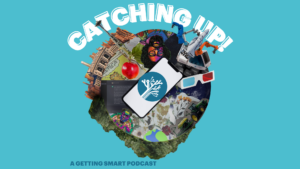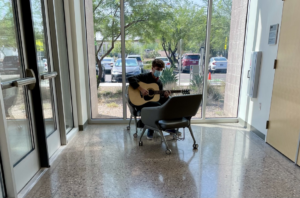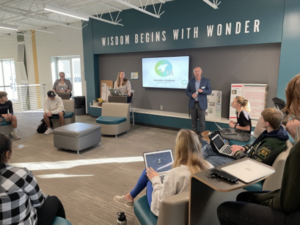Selective Attention Span Shapes the Length of Effective Instructional Experiences

My youngest son is a bundle of energy. His legs and arms are in constant motion, so much so that when he sits next to me at a booth or bench I have to move aside or risk a headache from the constant vibration.
For years teachers have told me that my son has a short attention span. They lament his inability to stay on task. That perception is belied by his 3.8 graduating GPA and the fact that he just landed a spot in an elite BFA program at a Southern California university.
My son does not have a short attention span – he can intently focus on a design task for hours, ignoring food, sleep, and those around him. He has a selective attention span.
You should be forgiven if you worry your children or students suffer from a short attention span as well. That widespread belief has been driven in part by a 2015 study on attention span commissioned by Microsoft. The study claimed that most people lose concentration after only eight seconds, drawing comparisons to the cognitive focus of goldfish.
This is click-worthy information and the ensuing deluge of flippant to serious commentary earned a vast amount of attention. But as a gruff, old editor told me when I was a cub reporter in Los Angeles, “don’t let facts get in the way of a good story.”
Schools and businesses have responded to our society’s presumptive lack of attention span. We are bombarded by offers to enroll in micro-credentialing programs. Nano-degrees have continued the miniaturization process.
The progression is clear. Technology has sharply reduced our ability to concentrate. Content providers, including schools, must respond to the attention deficit by developing content structured in small bites.
Entire business models have been built around the miniaturization of learning, including the extraordinary offerings from Udacity, which does a better job than anyone else in explaining how nanodegrees work:
- A nanodegree program is a project- and skills-based educational credential program.
- You enroll, you learn a suite of skills, you successfully complete a certain amount of projects that demonstrate your mastery of these skills, and you receive a credential affirming your mastery of these skills.
- Learning in a nanodegree program takes place primarily online, so it can be said that a nanodegree is an online learning credential program.
One of the clearest descriptions of nanodegrees is offered by the National Association of State Boards of Accountancy: “A Nano Learning program is a tutorial program designed to permit a participant to learn a given subject in a ten-minute time frame through the use of electronic media and without interaction with a real time instructor. A Nano Learning program … is typically focused on a single learning objective and cannot be paper based. A Nano Learning program is not a group program.”
But just as fast food created a reaction that manifests itself today in the slow dining movement, so too has the nano-learning craze produced a response. The first attack is against the research that started the conversation.
The BBC did not mince words in a piece called Busting the Attention Span Myth. Author Simon Maybin tried to track down the source of the key statistic in the Microsoft report but failed. The four organizations (National Center for Biotechnology Information, U.S. National Library of Medicine, Associated Press, and Statistic Brain) that initially mentioned the germane data point were unable to find any record of research that backs up the eight-second statistic.
Tech company Prezi partnered with the consulting firm Kelton Research to conduct a study “to gauge the effectiveness of content and presentations and to better understand how they resonate with business professionals across demographics, including millennials, Generation X and baby boomers.” The most intriguing finding suggests our ability to maintain focus is actually improving because we are becoming more adept at selecting the content we wish to engage with.
Designers in particular have responded negatively to the idea of nano-learning. Jon Kolko, a partner at Modernist Studio and the founder of Austin Center for Design, recently penned a piece called The Failure of Fast Education. His critique is practical:
“And so my biggest concern with workshops, bootcamps, and the majority of the non-traditional learning programs that have emerged in our creative fields is that they are just too short. And the unfortunate reality is that the people who need the vocational training and want the jobs and should be employable and are transitioning to a design career aren’t given enough time to learn.“
A team of researchers from Cal and Princeton worked on a study that claims human ability to stay focused is actually unchanged and in part driven by evolutionary pressures. According to the report, “Being able to flick between highly focused and diffuse attention gives us the ability to concentrate on a complex task while also being aware of our surroundings, making us the dynamic, hyper-alert creatures that we are today.”
The research team offers a simile that illuminates how we can maintain attention when our bursts of focus (250 milliseconds) are so short: “The brain is like a theater with a spotlight and house-lights, and it cycles between spotlight mode (attention focused on a single point on the stage), and house-light mode (attention is diffused over the audience). The constant transition from spotlight to house-lights creates a pulsating, strobe-like effect.”
As you may know, I’ve been walking around the perimeter of the theory of selective attention, a mainstay of cognitive psychology. According to Sam McLeod writing for Simply Psychology, this theory is based on the idea that “selective attention is the process of directing our awareness to relevant stimuli while ignoring irrelevant stimuli in the environment. This is an important process as there is a limit to how much information can be processed at a given time, and selective attention allows us to tune out insignificant details and focus on what is important.”
All learners experience selective attention. Accordingly, instructional experiences should be structured to maximize that reality. Lamenting a short attention span is a waste of time.
And so micro-credentials and nanodegrees have their place on the menu of educational options learners should be offered. They fulfill a time-sensitive need but work best when supplemented by extended inquiries into complex topics that are of deep interest to the learner. Educators, though, should constantly be aware of the “strobe-like effect” of learners’ attention, and my son and I are prime examples of how that works.
Rumor has it that the apple doesn’t fall far from the tree. I took the attention-span test offered by the magazine Psychology Today to understand how alike my son and I are. I got a 73, which means I don’t have trouble staying focused. My wife disagrees.
For more see:
- Social Media Jacked Your Attention And Sold It, How to Get It Back and Thrive
- Is Personalized Learning the Latest Tool To Increase Student Engagement?
- NanoProfessor Increases Access to Front-Edge STEM Learning
Stay in-the-know with innovations in learning by signing up for the weekly Smart Update.







0 Comments
Leave a Comment
Your email address will not be published. All fields are required.